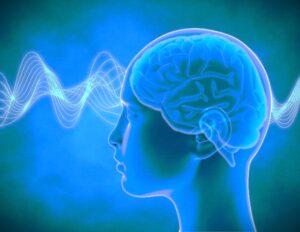Here are the 10 Amazing facts about the Brain Waves :
- Brain Waves Travel at Different Speeds: While different types of brain waves have distinct frequencies, they also travel at varying speeds. Some waves, like gamma waves, move at a rapid pace, while others, such as delta waves during deep sleep, have a much slower rhythm.
- Brain Waves Change with Age: The patterns of brain waves evolve throughout a person’s life. For instance, infants predominantly exhibit delta and theta waves, which gradually shift towards a higher prevalence of alpha and beta waves as they grow and develop.
- Gamma Waves and Higher Cognitive Functions: Gamma waves, with frequencies ranging from 30 to 100 Hz, are associated with higher cognitive functions. They play a crucial role in information processing, memory, and even the integration of sensory input.
Brain waves thinking process, concentration concept blue background. - Brain Waves and Emotional Resonance: Brain waves can synchronize with external stimuli, including music. This synchronization, known as “brainwave entrainment,” can induce specific emotional states. For example, listening to music with a beat that matches the natural frequency of alpha waves may promote a sense of calm.
- The Brain’s Symphony During Sleep: While delta waves dominate deep sleep, there are periodic bursts of rapid brain activity known as sleep spindles. These short bursts are rich in theta waves and are believed to play a role in memory consolidation.
- Individual Variability in Brain Wave Frequencies: The frequency of brain waves can vary significantly among individuals. What may be a typical alpha wave frequency for one person might differ for another. This individual variability contributes to the uniqueness of cognitive processes.
- Brain Waves and Lucid Dreaming: Research suggests a link between theta waves and lucid dreaming. Lucid dreamers, those who are aware they are dreaming and can sometimes control their dreams, often exhibit increased theta wave activity during these experiences.
Click Here Learn How to improve it - Brain Waves Influence Perception: Studies indicate that the frequency of brain waves can influence how we perceive the world around us. For instance, certain gamma wave patterns are associated with increased attention and heightened perception, potentially enhancing our ability to process information.
- Brain Waves in Cross-Modal Sensory Processing: Brain waves play a role in cross-modal sensory processing, where information from different senses is integrated. The synchronization of brain waves across regions helps create a unified perception of the surrounding environment.
- Brain Waves and Neurofeedback Training: Neurofeedback, a therapeutic technique, leverages real-time monitoring of brain wave activity. By providing individuals with feedback about their brain waves, they can learn to self-regulate and potentially improve cognitive functions, such as attention and emotional regulation.Click Here Learn How to improve it

